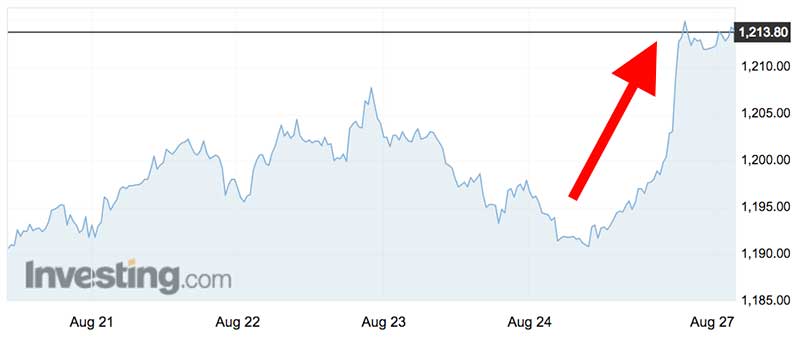Good news for gold stocks as evidence points to price recovery

Pic: Schroptschop / E+ via Getty Images
Tipping the future gold price is not rocket science but it is easy to understand the theory behind a forecast that gold could take off (rocket-like) — unless it does what some rockets do and blow up on the launch pad.
Putting 50c each-way on gold is what most analysts do because gold is tough to tip thanks to its unique status — which includes being a global currency.
But right now there are clear signs that gold is poised to take off.
First target, according to investment bank Morgan Stanley, is $US1300 an ounce — up 7 per cent on its latest price of $US1217/oz – which is already a $US33 jump on its low point of $US1184/oz.
If the bank is right that means gold should recoup much of the value lost over the past four months, which is not much to write home about.
However, what becomes interesting with gold — and the reason investors have an appetite for the metal in its many forms (bullion, shares and exchange-traded funds) — is a rising tide of evidence pointing to gold enjoying a stronger and longer recovery.

If in doubt, tick off this check list of gold-price positive factors:
— Currency turmoil as China and the U.S. exchange blows in a trade war that some economists believe will soon see both sides “weaponise” their currencies.
— Record short-selling of gold by speculators, which has helped drive the price down but which, in the past has been followed by an upward surge in the gold price as short-sellers buy back.
— Increased consumer buying of gold for jewellery because the price has fallen with Indian consumers returning to the market ahead of the annual wedding season which traditionally starts in October followed by the Diwali festival in early November, and
— A long-term gold shortage which Stockhead covered last week where researcher S&P Global Market Intelligence forecast a decline next year in Australian gold production and a potential global decline starting in four years’ time.
Powerful set of infuencers
On their own each one of those factors could be enough to influence the gold price.
Collectively they are a powerful set of potential influencers on gold which is why expert commentary is switching from being gold negative to gold positive.
Currency, the first of the four dynamics developing in the gold market, is also the most important because of the intimate connection between gold and the value of the U.S. dollar, the currency in which most gold is traded.
Almost invariably when the US dollar rises, gold falls because the two share a common feature as a store of value in troubled times and investors are prepared to overlook gold’s big drawback; it doesn’t pay interest in its bullion form whereas the dollar does on bond and bank deposits.
Over the past 12 months US interest rates have been rising as that country’s central bank attempts to “normalise” the economy after the global financial crisis and a flood of cash to prop up business and consumers
The Trump factor
But rising interest rates have not pleased the ultimate wild card in the gold pack — President Donald Trump, who has criticised his own central bank and says he wants lower interest rates, and a lower dollar to aid US exporters.
Charles Dallara, a former US Treasury official and an architect of the Plaza Accord which saw five leading countries jointly act to depreciate the dollar in 1985 reckons the current trade war will lead to a currency conflict.
“It’s inevitable,” he told Bloomberg.
If the value of the dollar is depreciated to aid US exporters the gold price will get a kick up.
The role of short sellers has been noted by several banks in their latest analysis of the gold market, including ANZ, which last week said that there was a record level of gold-short positions.
In the past, high levels of shorting was followed by a gold-price surge.
In 1999 gold rose by 16 per cent when shorters closed out. In 2005 there was a rally of 12 per cet when shorters bough back the gold they had “sold”, and just two years ago there was a 14 per cent price spike.
ANZ’s view is contained in the headline of its gold report: “Pot of gold” and a comment above a gold-price graph: “record high short positions could spark a short-covering rally”.
Indian buying is even more predictable than short-covering with the wedding season and a number of religious festivals in the second half of the year — including Diwali for which even the Perth Mint has issued a commemorative gold coin.
Long term outlook
Longer term there is the S&P report on a looming gold shortage — a potential gold-price mover though perhaps the weakest of the reasons to feel optimistic about gold.
Any global decline is years away and even then, it would take a significant decline to influence the market.
Gold bugs — those investors who are believers in gold being the only currency safe from government manipulation — reckon the seeds are being sown for a strong price recovery, perhaps starting before the end of the year when Indian buyers return for Diwali.
But the real driver could be what happens in the US, where an increasingly embattled President is looking for circuit breakers in his battle with political and legal opponents while also starting grass fires around the world with Mexico, Canada, Germany, Turkey and South Africa among the targets of his attacks.
China, however, is the ultimate bogeyman for Trump and as the tit-for-tat tariff war heats up (and probably fails to force Chinese capitulation) a new weapon will be required, and what better than a hefty devaluation of the dollar – which is what weaponising means.
If or when Trump plays the currency card, gold will move higher.
Perhaps a lot higher.
UNLOCK INSIGHTS
Discover the untold stories of emerging ASX stocks.
Daily news and expert analysis, it's free to subscribe.
By proceeding, you confirm you understand that we handle personal information in accordance with our Privacy Policy.








